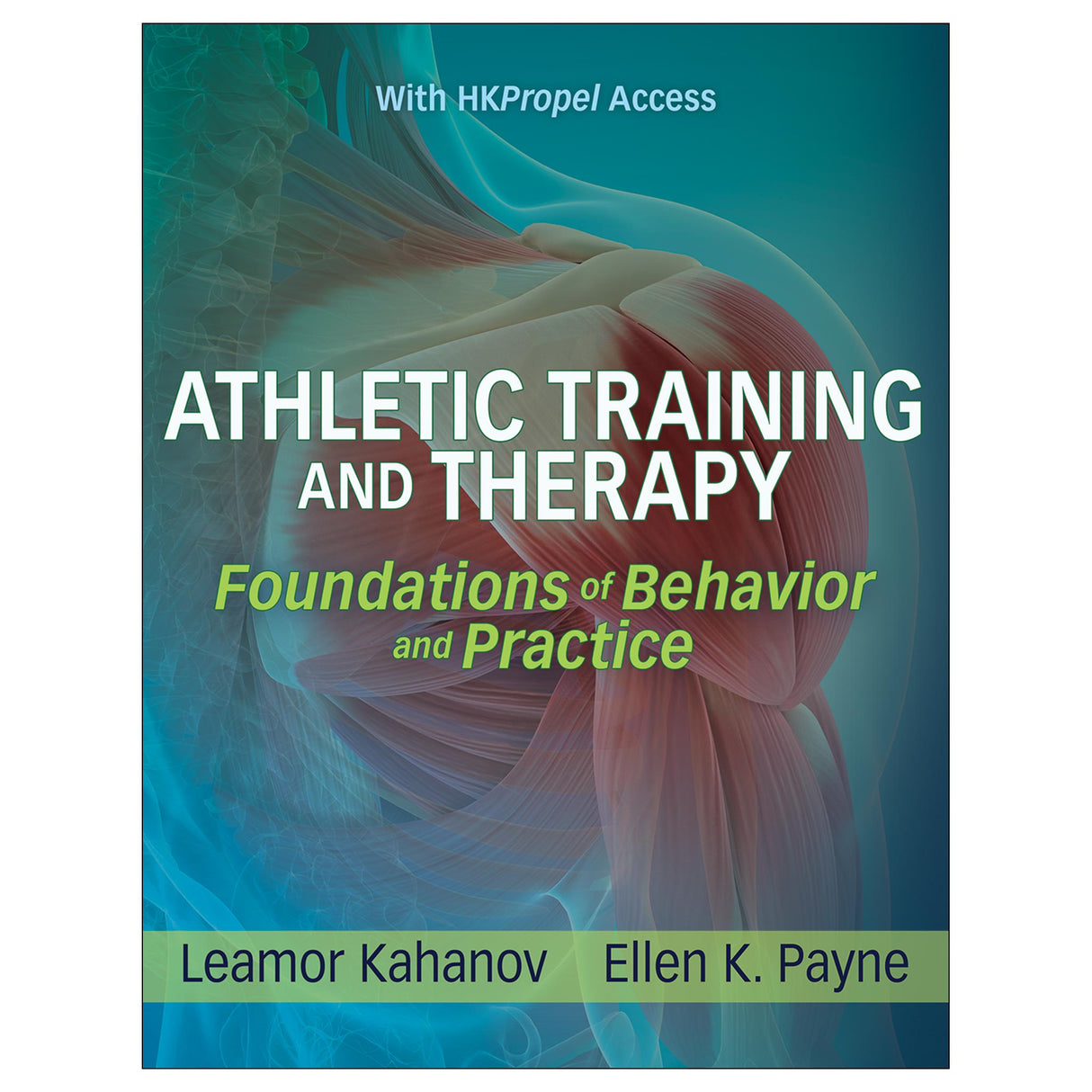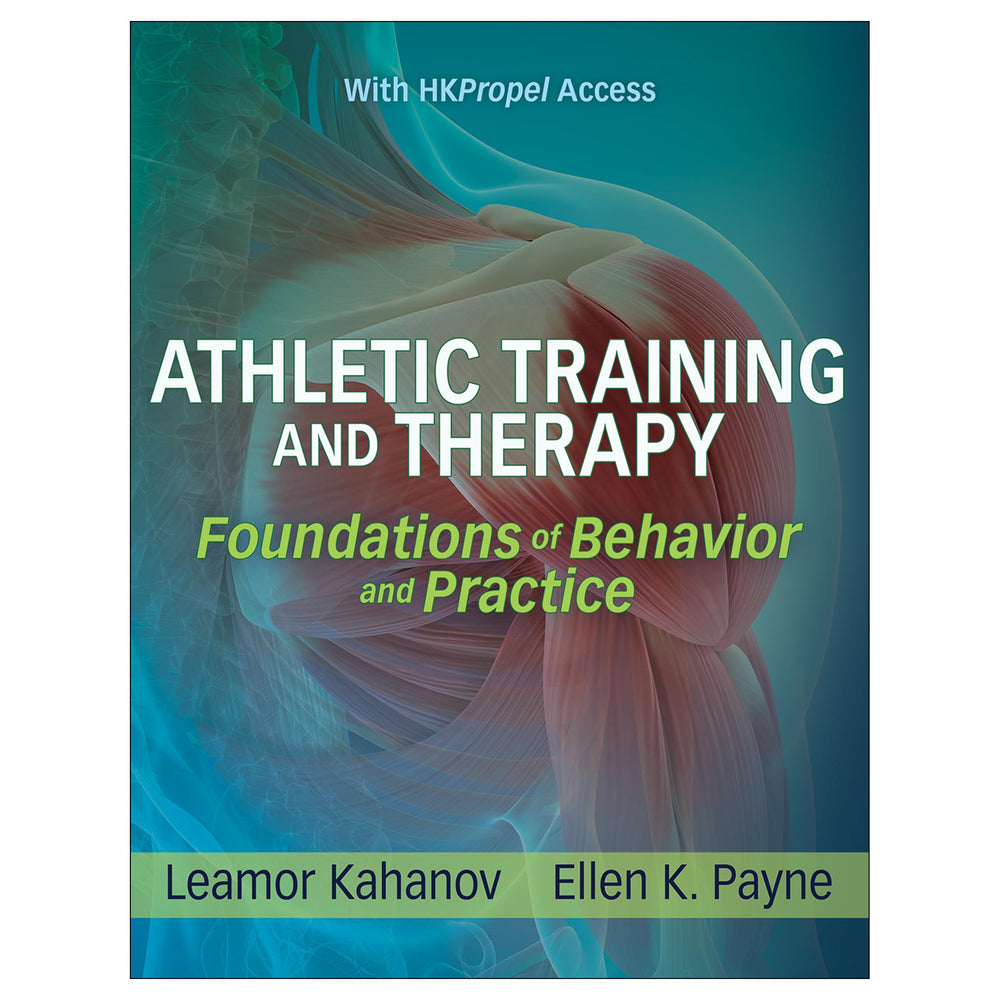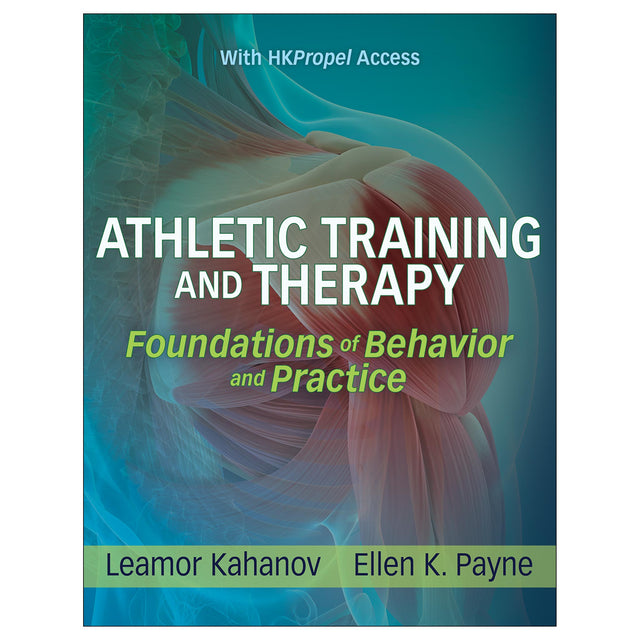Athletic Training and Therapy Ebook With HKPropel Access
Foundations of Behavior and Practice
Author: Leamor Kahanov, Ellen K. Payne
$82.00 USD

Athletic Training and Therapy highlights contemporary concepts not often found in other introductory texts, such as cultural literacy, interprofessional practice, preventative health care, administrative management, special populations, and epidemiology. Students gain a complete picture of their role as an athletic trainer as they explore these topics and progress through the text.
Part I covers foundational clinical competencies that will guide students in their future professional practice. Part II features holistic wellness concepts and proactive strategies to prevent illness and injury. Part III presents emergency interventions for acute injury and immediate care. Part IV offers information on evaluating illness and injury. Part V addresses therapeutic and medical interventions, including therapeutic exercises, pharmacology, and casting procedures.
The full-color text engages students and fosters comprehension with learning aids:
- Evidence-Based Athletic Training sidebars that highlight a position statement, systematic literature review, or high-level randomized control trials
- Foundational Skills sidebars that provide step-by-step instructions for common skills required of entry-level athletic trainers
- Chapter summaries of key concepts
- Learning objectives to help students focus their studies during their graduate education and during preparation for the BOC examination
- Related digital content delivered through HKPropel: videos of select skills and techniques, gradable chapter quizzes, case studies with critical thinking questions for each chapter, and checklists that can be used to grade students on their ability to accurately perform foundational skills
Note: A code for accessing HKPropel is included with this ebook.
Audience
Textbook for entry-level graduate athletic training courses.Part I. Foundations of Professional Practice
Chapter 1. Athletic Training and the Health Care Team
Leamor Kahanov, EdD, ATC, LAT
Becoming an Athletic Trainer
Interprofessional Approach to Health Care Delivery
Athletic Trainers as Members of Health Care Teams
Athletic Training History
Professional Ethics
Clinical Bottom Line
Chapter 2. Evidence-Based Practice and Basic Research Principles
Leamor Kahanov, EdD, ATC, LAT
Definition of Evidence-Based Practice
Research Design and Levels of Evidence
Qualitative and Quantitative Research
Critical Appraisal of the Literature
Applying Evidence-Based Practice
Understanding Diagnostic Tests
Research Ethics and Institutional Review Board
Clinical Bottom Line
Chapter 3. Public Health and Athletic Training
Samuel Johnson, PhD, ATC, CSCS
Defining Public Health
Intersection of Athletic Training and Public Health
Sequence of Prevention
Clinical Bottom Line
Chapter 4. Cultural Literacy in Patient-Centered Care
Marsha Grant-Ford, PhD, ATC; and Leamor Kahanov, EdD, ATC, LAT
Patient-Centered Care Definition
Person-First Language
Group Identities
Culture, Ethnicity, and Personal Core Values
Race
Professional Culture and Core Values
Stereotypes
Privilege
Microaggressions
Adverse Childhood Experiences
Social Determinants of Health
Cultural Competence
Clinical Bottom Line
Chapter 5. Health Care Administration and Health Care Informatics
Leamor Kahanov, EdD, ATC, LAT
Health Care Administration and Management
Health Policy and Laws
Quality Assurance
Documentation and Medical Records
Insurance, Third-Party Reimbursement, and Billing
Clinical Bottom Line
Chapter 6. Management, Planning, and Professional Development
Leamor Kahanov, EdD, ATC, LAT
Management and Leadership
Planning
Facility Planning
Budgeting
Purchasing
Risk Management
Advocacy
Clinical Bottom Line
Part II. Injury and Illness Prevention and Wellness Promotion
Chapter 7. Blood-Borne Pathogens
David C. Berry, PhD, MHA, AT, ATC; and Ellen K. Payne, PhD, LAT, ATC, EMT
Means of Pathogen Entry
Common Pathogens
Exposure Control Plan
Exposure Incident
Training
Clinical Bottom Line
Chapter 8. Prevention Strategies and Procedures
Ellen K. Payne, PhD, LAT, ATC, EMT
Preparticipation Physical Examination
Thermoregulatory Mechanisms
Hyperthermia
Hypothermia and Cold-Related Conditions
Lightning
Ergonomics
Clinical Bottom Line
Chapter 9. Fitness and Wellness
Angela Hillman, PhD
Role of Exercise in Maintaining a Healthy Lifestyle
Definition of Exercise
Standardized Testing in Fitness and Wellness
Designing a Fitness Program
Instructing a Patient Through Fitness Exercise
Safety Precautions and Hazards
Clinical Bottom Line
Chapter 10. General Nutrition Concepts and Sports Nutrition
Ellen K. Payne, PhD, LAT, ATC, EMT; and Jennifer Doane, MS, RDN, CSSD, LDN, ATC
Energy and Nutrition Needs
Macronutrients
Micronutrients
Fluids
Nutrition for Optimal Healing
Low Energy Availability
Dietary Supplements
Clinical Bottom Line
Chapter 11. Protective Equipment
Ellen K. Payne, PhD, LAT, ATC, EMT
Legal Issues
Basic Application of Protective Equipment
Emergency Removal of Protective Equipment
Clinical Bottom Line
Chapter 12. Taping and Bracing
David A. Wilkenfeld, EdD, LAT, ATC
Legal Issues
Principles of Prophylactic Procedures
Taping and Wrapping Techniques for the Lower Extremity
Taping and Wrapping Techniques for the Upper Extremity
Clinical Bottom Line
Part III. Immediate and Emergency Care
Chapter 13. Emergency Planning in Health Care
Ellen K. Payne, PhD, LAT, ATC, EMT
Components of an Emergency Action Plan
Types of Emergencies Covered in an Emergency Action Plan
Developing an Emergency Action Plan
Special Considerations
Clinical Bottom Line
Chapter 14. Acute Care and Emergency Procedures
Ellen K. Payne, PhD, LAT, ATC, EMT; and David C. Berry, PhD, MHA, AT, ATC
Principles of Emergency Assessment
Moving and Transporting the Injured or Ill Patient
Emergency Interventions
Clinical Bottom Line
Part IV. Injury and Illness Evaluation
Chapter 15. Pathophysiology of Musculoskeletal and Nerve Injury
James R. Scifers, DScPT, PT, LAT, ATC
Soft Tissue Injury
Bone Injury
Nerve Injury
Clinical Bottom Line
Chapter 16. Clinical Diagnosis and Medical Referral
Ellen K. Payne, PhD, LAT, ATC, EMT
Clinical Assessment and Diagnosis
History
Observation
Palpation
Special Tests
Additional Assessment Components
Variations in the Assessment Process
Concussion Evaluation
Clinical Prediction Rule
Medical Referral
Documentation and Communication of the Injury Evaluation
Clinical Bottom Line
Chapter 17. Medical Imaging
Leamor Kahanov, EdD, ATC, LAT; and Loraine Zelna, MS, RT (R)(MR)
Radiologic Science and Its Roles in Imaging
Medical Imaging
Computed Tomography
Magnetic Resonance Imaging
Ultrasound or Diagnostic Medical Sonography
Nuclear Medicine
Imaging Life Cycle
Clinical Bottom Line
Chapter 18. Commonly Encountered Medical Conditions in Athletic Training
Tim Braun, PhD, LAT, ATC, CSCS
Examination Process
Diagnostic Tests
Infectious Diseases
Respiratory System Conditions
Cardiovascular System Conditions
Gastrointestinal System Conditions
Genitourinary System Conditions
Nervous System Conditions
Eye Conditions
Ear, Nose, Throat, and Mouth Conditions
Systemic Disorders
Sexually Transmitted Diseases
Dermatological Conditions
Clinical Bottom Line
Chapter 19. Psychosocial Interventions in Athletic Training Health Care
Paul Knackstedt, MS, PsyD, CMPC
Prevalence of Psychosocial Disorders
Common Mental Health Disorders
Psychological Response to Injury
Psychosocial Interventions
Clinical Bottom Line
Chapter 20. Special Populations
Monique Mokha, PhD, LAT, ATC, CSCS; and Leamor Kahanov, EdD, ATC, LAT
Tactical Athletes
Masters Athletes
Pediatric Athletes
Pregnant Athletes
Introduction to Disability
Athletes With Visual Impairments and Blindness
Deaf Athletes and Athletes With Hearing Loss
Athletes With Amputations
Athletes With Spinal Cord Injury
Autonomic Dysreflexia
Athletes With Cerebral Palsy
Athletes With Intellectual Disabilities
Athletes With Les Autres
Clinical Bottom Line
Part V. Therapeutic and Medical Interventions
Chapter 21. Therapeutic Modalities and Interventions
Leamor Kahanov, EdD, ATC, LAT
Thermal Modalities
Electrical Modalities
Electromagnetic Modalities
Sound Modalities
Mechanical Modalities
Soft-Tissue Mobilization
Evolving and Emerging Therapeutic Modalities
Purchasing and Maintaining Equipment
Clinical Bottom Line
Chapter 22. Therapeutic Exercise in Rehabilitation
Mitchell Wasik, MS, ATC, LAT; and Leamor Kahanov, EdD, ATC, LAT
Therapeutic Exercise Overview
Physical Inactivity and Immobilization
Rehabilitation Program Essentials
Rehabilitation Phases Based on Tissue Healing
Therapeutic Strengthening, Endurance, and Power Exercises
Neuromuscular Control
Practitioner-Assisted Therapeutic Exercise
Purchasing and Maintaining Therapeutic Exercise Equipment
Clinical Bottom Line
Chapter 23. Pharmacological Interventions
Leamor Kahanov, EdD, ATC, LAT
Pharmacokinetics and Pharmacodynamics
Legal Issues and Regulations
Managing a Formulary
Drug Testing
Common Medications in Athletic Training
Commonly Abused Drugs and Supplements
Special Considerations
Clinical Bottom Line
Chapter 24. Casting
Bryce B. Gaines, LAT, ATC
Basic Principles
Materials for Application
General Application Tips
Cast Removal Procedures
Upper Extremity Casts
Lower Extremity Casts
Postcasting Care Considerations
Special Considerations
Clinical Bottom Line
Appendix. Standard Medical Terminology and Abbreviations
Managing a safe and legal formulary
Psychosocial interventions in the rehabilitation setting
Understanding privilege and microaggressions



All ancillaries are free to adopting instructors through HKPropel.
Instructor guide. Includes an introduction, sample syllabus, lecture outlines, suggested student activities, and answers to the case studies.
Test package. Contains more than 600 questions in true-false, fill-in-the-blank, short-answer, and multiple-choice formats.
Chapter quizzes. Contains ready-made quizzes (10 questions each) to assess student comprehension of the most important concepts in each chapter. Quizzes can be imported into learning management systems.
Presentation package. Includes more than 800 PowerPoint slides of text, artwork, photos, and tables from the book that can be used for class discussion and presentation. The foundational skill videos are included, too. The slides in the presentation package can be used directly within PowerPoint or printed for distribution to students. Instructors can easily add, modify, and rearrange the order of the slides.
Image bank. Includes most of the figures and tables from the text, sorted by chapter. These can be used in developing a customized presentation based on specific course requirements.
Instructors also receive access to all student materials in HKPropel.






